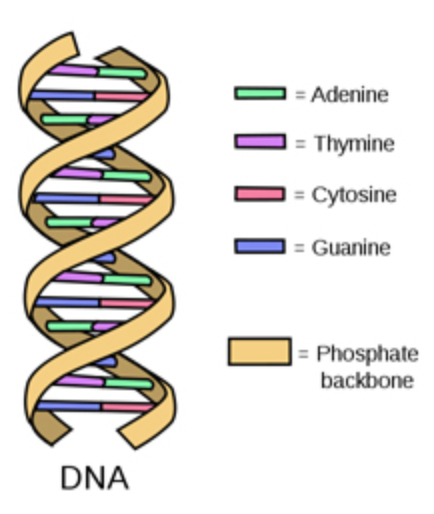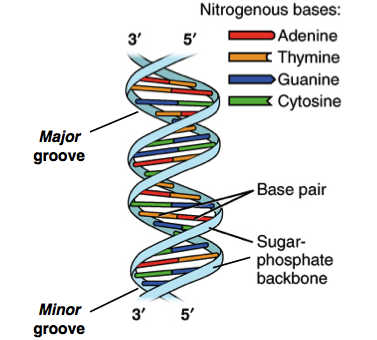Which choice describes DNA after replication has taken place. This area will be the template for replication to begin.

Dna Replication Biology Libretexts
It separates DNA strands 2.
. If the two strands of a DNA molecule are separated each can be used as a pattern or template to produce a complementary strand. DNA Polymerase adds complimentary nucleotides to each strand 3. DNA Replication Process in Prokaryotes.
Either dispersive of conservative depending on the organism. 3 DNA ligase and an enzyme that degrades RNA primers to seal together the discontinuously synthesized lagging-strand DNA fragments. Which choice describes DNA after replication has taken place.
DNA polymerase can only synthesize DNA in the 5 to 3 direction. Two molecules each with two old strands. DNA is directional in both strands signified by a 5 and 3 end.
Before a cell divides its DNA is replicated duplicated Because the two strands of a DNA molecule have complementary base pairs the nucleotide sequence of each strand automatically supplies the information needed to produce its partner. The new DNA molecule consists of one strand of DNA. The new DNA molecule contains new DNA and the old molecule keeps the old DNA.
The new DNA molecule is synthesized from amino acids. DNA Replication Exam PART I - MULTIPLE CHOICE. Which best describes the outcome of DNA replication.
DNA replicates using the process called semiconservative replication. An original DNA molecule is complementary to the replicated molecule which means that they are identical copies of each other. The new DNA molecule has a different number of codons.
It forms bonds between DNA nucleotides. Meeselson and Stahl did an experiment to demonstrate the semi-conservative model. The new DNA molecule is identical to the original DNA.
A DNA Molecule Consists of Two Complementary Chains of Nucleotides. Each of these chains is known as a DNA chain or a DNA strandHydrogen bonds between the base portions of the nucleotides hold the two chains together As we saw in Chapter 2 Panel 2-6. Two molecules each with two new strands D.
The two strands of DNA unwind at the origin of replication. Helicase is the enzyme which rewinds the DNA after replication is finished. DNA helicase disrupts the hydrogen bonding between base pairs to separate the strands into a Y shape known as the replication fork.
DNA replicates and stores genetic information. The two strands of a DNA molecule separate and an exact copy of each strand is synthesized. Which choice describes how the DNA molecule replicates.
Two molecules each with one original and one new strand. One molecule with two original strands and one molecule with two new strands B. Two DNA molecules that are identical to each other.
Either dispersive or semiconservative depending on the pH e. DNA replication A occurs by the addition of nucleotides to the end of the DNA molecule. Each original strand pairs with one new strand in the replication product.
E begins when two DNA molecules join. DNA polymerase is the enzyme that adds nucleotides to one another. Helicase opens the DNA and replication forks are formed.
2 DNA helicases and single-strand DNA-binding SSB proteins to help in opening up the DNA helix so that it can be copied. The DNA replication in prokaryotes takes place in the following place. The DNA is coated by the single-strand binding proteins around the replication fork to prevent rewinding of DNA.
The two strands are separated and an enzyme called DNA-polymerase replaces the nitrogenous base for each strand resulting in two identical DNA molecules. Based upon their model for the structure of DNA Watson and Crick proposed that DNA replicates in a Semi-Conservative manner Figure 2. D produces two daughter DNA molecules that are complementary to each other.
Which best describes the outcome of DNA replication. Two molecules each with two new strands. The place where the parent DNA molecule becomes unzipped is called the.
The two original strands of DNA are separated by helicase at the replication fork 2. The new DNA molecule accumulates a new strand of DNA with each replication. CLICK HERE FOR ANSWER.
A DNA molecule consists of two long polynucleotide chains composed of four types of nucleotide subunits. RNA converts the genetic information contained within DNA to a format used to build proteins and then moves it to ribosomal protein factories. DNA polymerase can only add nucleotides to an existing strand.
It adds new nucleotides to the DNA helix. It is a blueprint for all genetic information contained within an organism. In this model the two strands of the DNA double helix unwind and separate and each parent strand serves as a template for the synthesis of a new daughter strand.
Select the best answer for each question or statement 3 points each 30 points total 1. The new DNA molecule consists of one new strand and one old strand of DNA. This is called semi-conservative replication because in each new DNA double helix one of the two strands is old and the other strand is newly replicated.
Biochemist Erwin Chargaff found that in DNA there was a special relationship between individual bases that we now refer to as Chargaffs rule. These include 1 DNA polymerase and DNA primase to catalyze nucleoside triphosphate polymerization. Two molecules each with one original and one new strand C.
One molecule with two original strands and one molecule with two new strands. DNA Replication--- transcription--- translation. At what point in the cell cycle does DNA.
All of the following are correct about DNA replication except. Two molecules each with two old strands. DNA consists of two strands arranged in a double helix.
This is performed by an enzyme known as DNA helicase. His observation was that. DNA is replicated through a process called semiconservative replication.
The new DNA molecule is single-stranded. The new DNA molecule is identical to the original DNA. C results in the formation of four new DNA strands.
It forms the DNA helix. The two strands of a DNA molecule unwind and an exact copy of one strand is synthesized. Up to 24 cash back Steps of DNA Replication.
The two strands of a DNA molecule separate and a complementary strand is synthesized from each original strand. B uses each strand of a DNA molecule as a template for the creation of a new strand. What is the function of helicase.
9 2 Dna Replication Concepts Of Biology 1st Canadian Edition

Dna Vs Rna 5 Key Differences And Comparison Technology Networks

0 Comments